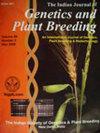喜马拉雅地区印度柳(Salix tetrasperma Roxb.)沿其分布范围具有优势分子标记的遗传多样性和群体结构
IF 1
4区 生物学
Q3 PLANT SCIENCES
引用次数: 0
摘要
印度柳树(Salix tetrasperma)是一种在农业上有用的树木,分布在南亚的广阔地理区域,具有重要意义。到目前为止,该物种从未进行过分子遗传多样性研究。因此,本研究旨在利用RAPD和ISSR分子标记评估北印度五个种群不同基因型的遗传多样性和种群结构分析。利用RAPD+ISSR标记获得有效等位基因的平均数、Shannon信息指数和基因多样性,分别为1.38±0.013、0.35±0.010和0.23±0.007。RAPD和ISSR的分子变异分析表明,群体内的遗传变异率(87%)高于群体间的遗传变异(13%)。查谟和克什米尔和旁遮普邦人群的Nei遗传距离最大(0.185)。RAPD标记与ISSR标记之间存在显著的Mantel相关性(r=0.551)。通过STRUCTURE软件获得的贝叶斯聚类模式显示了四个基因库。根据利用RAPD和ISSR标记系统获得的印度柳树遗传信息,提出在种群内而不是种群间选择单株,以改善印度柳树的经济性状,同时保护整个生态种群。本文章由计算机程序翻译,如有差异,请以英文原文为准。
Genetic diversity and population structure of Indian willow (Salix tetrasperma Roxb.) with dominant molecular markers along its distribution range in Himalayan region
Indian willow (Salix tetrasperma) is an agriculturally useful tree which occurs over a wide geographic area across South Asia and bears importance. So far, this species has never been studied for molecular genetic diversity. The present study was, therefore, carried out to assess the genetic diversity and population structure analysis using RAPD and ISSR molecular markers in diverse genotypes from five populations covering North India. The mean number of effective alleles, Shannon information index and gene diversity i.e., 1.38 ± 0.013, 0.35 ± 0.010 and 0.23 ± 0.007, respectively were obtained with RAPD + ISSR markers. The analysis of molecular variance generated by RAPD + ISSR revealed a higher genetic variation (87%) within population as compared to that of among population (13%). Nei genetic distance was maximum (0.185) between Jammu and Kashmir and Punjab populations. Significant Mantel correlation (r=0.551,) was obtained between RAPD and ISSR markers. Bayesian clustering pattern obtained through STRUCTURE software showed four gene pools. Based on the genetic information obtained with regards to Indian willow by combining the RAPD and ISSR marker systems, it is proposed that an individual tree be selected within populations rather than among populations for the improvement of economic traits of Indian willow alongwith conservation of entire ecological populations.
求助全文
通过发布文献求助,成功后即可免费获取论文全文。
去求助
来源期刊

Indian Journal of Genetics and Plant Breeding
PLANT SCIENCES-
CiteScore
1.80
自引率
10.00%
发文量
0
审稿时长
6-12 weeks
期刊介绍:
Advance the cause of genetics and plant breeding and to encourage and promote study and research in these disciplines in the service of agriculture; to disseminate the knowledge of genetics and plant breeding; provide facilities for association and conference among students of genetics and plant breeding and for encouragement of close relationship between them and those in the related sciences; advocate policies in the interest of the nation in the field of genetics and plant breeding, and facilitate international cooperation in the field of genetics and plant breeding.
 求助内容:
求助内容: 应助结果提醒方式:
应助结果提醒方式:


